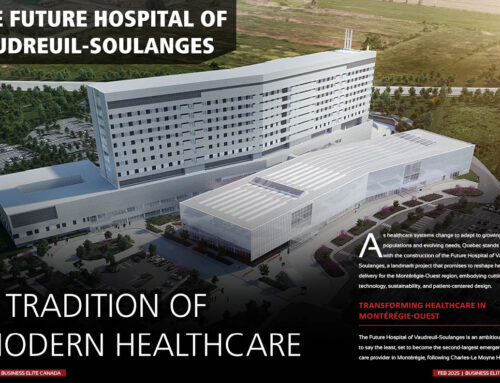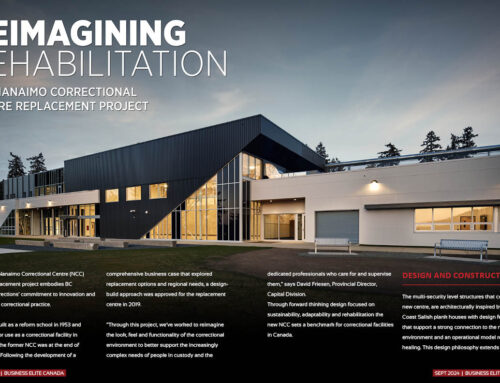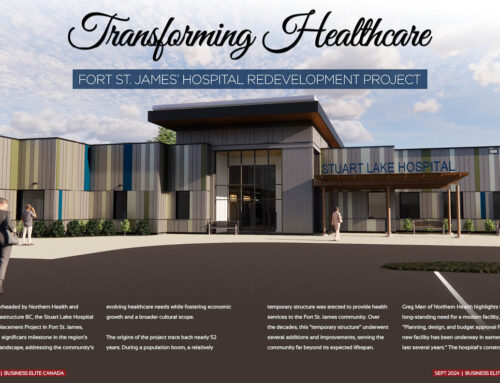Sunnybrook’s New World-Class Facility
The Garry Hurvitz Brain Sciences Centre, located at the Sunnybrook Health Sciences Centre’s Bayview campus in Toronto, is a groundbreaking facility designed to transform the delivery of brain health care and research. The building’s patient-centered approach, coupled with state-of-the-art design and functionality, represents a new frontier in healthcare infrastructure.
Putting Patients First
At the heart of the project was the mission to create a space that prioritized patients and their families. Anton Krish Rabindran, Director of Capital Development, tells Business Elite Canada that the importance of engaging former patients and family members in the design process was from the very beginning. “We had the Patient and Family Advisory Council (PFAC) at the design table from day one,” says Rabindran. This collaboration brought invaluable insights, resulting in features like integral window blinds controllable by patients, multiple lighting zones to avoid nighttime disruptions, and numerous rooms with smart glass for privacy on demand.
The design also incorporated non-institutional elements, reflected in but not limited to the furniture finishes, fireplaces, and welcoming lounges. Such details, Rabindran explained, aimed to create a homelike atmosphere. “The goal was to reduce the anxiety often associated with clinical environments and make the space as inviting as possible,” he added.
Revolutionary Clinical Capabilities
The Garry Hurvitz Brain Sciences Centre is a purpose built environment to allow and enable the co-location of experts in psychiatry, neurology, neurosurgery, and other disciplines. This integration facilitates a comprehensive approach to brain disorders, with resources like the Harquail Centre for Neuromodulation leading the charge.
“The Harquail Centre is truly one of a kind in Canada,” shares Dr. Nir Lipsman, Chief of the Hurvitz Brain Sciences program. “It offers a full range of direct-to-brain interventions for highly resistant mental health conditions, from ECT and rTMS to advanced techniques like focused ultrasound and deep brain stimulation.” These cutting-edge therapies promise hope for patients with conditions like depression and OCD, where traditional treatments often fall short.
Additionally, the Centre includes Circadian Sleep Rooms, designed for patients requiring complete darkness and silence for extended periods. This innovative approach underscores the Centre’s commitment to advancing both care and research.
Clinical trials are the backbone of medical progress, and the Garry Hurvitz Brain Sciences Centre is poised to be a hub for groundbreaking studies. “We currently have more clinical trials in the brain space than anywhere at Sunnybrook,” says Dr. Lipsman. By consolidating these efforts under one roof, the Centre fosters collaboration and accelerates the development of new therapies.
Dr. Lipsman further noted that the Centre’s infrastructure supports every stage of the research process, from patient assessment to data collection. “The building and the data that comes from inside it will benefit patients not only by providing options for more experimental treatments but by ultimately delivering therapies developed here at home.”
Innovative Construction Techniques
Building a facility that met the technical demands of brain science care while ensuring architectural elegance was no small feat. One standout feature is the reinforced exterior windows designed to withstand up to 2,000 pounds of force, ensuring patient safety. Additionally, inpatient bedrooms were equipped with pick-proof caulking and utilities that could be independently controlled by nursing staff, minimizing risks of flooding or harm.
The center also boasts two Circadian Sleep Rooms, where patients requiring isolation from light and sound for up to 72 hours can still receive necessary care. “These specialized spaces reflect our commitment to balancing cutting-edge medical requirements with patient comfort,” says Rabindran. “The building is designed to support an additional four floors while maintaining operations below”.
Overcoming Construction Challenges
As with any large-scale construction project, challenges were inevitable. The team faced union strikes, adverse weather, unforeseen site conditions, and COVID-19-related supply chain delays. Nevertheless, “We executed weekend and evening work to compensate for delays and conducted focused meetings with subject matter experts to resolve issues,” says Rabindran. “Our collaboration with Maystar General Contracting, their subtrades, and consultants was crucial in overcoming these challenges.”
Efficiency and Functionality
One of the center’s standout achievements is its efficient use of space. Exam rooms double as sleep rooms at night and are designed to accommodate over 13 different clinics. This adaptability ensures optimal utilization of resources, a crucial factor in healthcare infrastructure.
Moreover, the layout separates adult and adolescent inpatient populations, providing each group with dedicated ancillary spaces, such as courtyards, lounges, and laundry rooms—to enhance patient experiences and streamlines operations for healthcare professionals.
Rabindran believes the center’s layout fosters collaboration among clinicians and researchers. By centralizing experts from diverse specialties, the Centre acts as a crucible for innovation, tackling complex brain disorders like dementia and major depression from multiple angles.
“By bringing everyone together under one roof, we’ve created an environment that encourages interdisciplinary teamwork and enhances the quality of care,” says Rabindran. “The field is just too large and moving too fast for any one discipline to tackle alone,” adds Dr. Lipsman.
The Garry Hurvitz Brain Sciences Centre is not only a haven for patients but also a highly functional space for medical staff and researchers. Real-Time Locating Systems (RTLS) enhance safety for both patients and staff, while advanced finishes, such as wood ceilings and special wall treatments, complement the technical sophistication of the facility.
A Lasting Impact on Brain Health Care
The Garry Hurvitz Brain Sciences Centre is poised to make a lasting impact on both patient care and research. For inpatients, access to natural light, exterior courtyards, and various programming options will promote improved well-being and recovery outcomes. For outpatients, the consolidation of clinical and research teams into one purpose-designed building facilitates more integrated and innovative care.
The Garry Hurvitz Brain Sciences Centre exemplifies how thoughtful design and cutting-edge construction can redefine healthcare spaces. From its patient-centric features to its innovative infrastructure, the center sets a new standard for facilities dedicated to brain sciences. As it begins serving patients and researchers alike, its legacy of excellence will undoubtedly inspire future projects in the healthcare sector.
“The center embodies everything we strive for in neuroscience: bringing together the brightest minds, from all brain disciplines, under one roof to focus on a common problem,” says Dr. Lipsman. “In this case tackling nothing less than changing how we understand and treat the most common brain disorders. Bringing people together is what’s always excited me about academic medicine, and that’s what the building represents. It also happens to be a beautiful place to walk through and work.”
“This project represents a new benchmark in brain health care,” says Rabindran. “By prioritizing patients, leveraging advanced technologies, and fostering collaboration, we’ve created a space that will drive better outcomes for years to come.”
For more information on the Garry Hurvitz Brain Sciences Centre, please visit www.sunnybrook.ca/content/?page=bsp-garry-hurvitz-brain-sciences-centre






